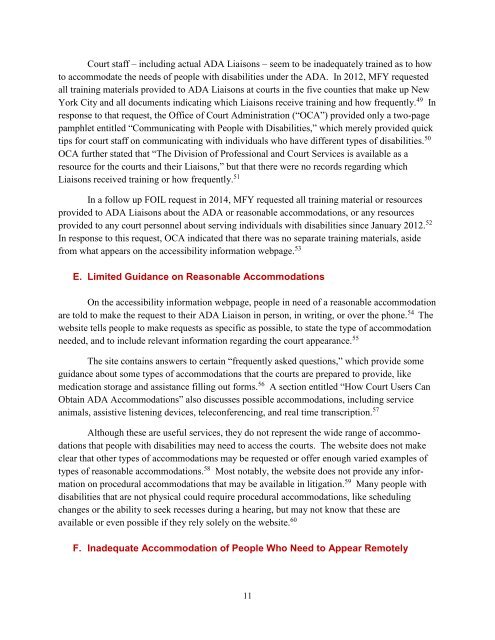Barriers to Justice
kAst305MjV6
kAst305MjV6
Create successful ePaper yourself
Turn your PDF publications into a flip-book with our unique Google optimized e-Paper software.
Court staff – including actual ADA Liaisons – seem <strong>to</strong> be inadequately trained as <strong>to</strong> how<br />
<strong>to</strong> accommodate the needs of people with disabilities under the ADA. In 2012, MFY requested<br />
all training materials provided <strong>to</strong> ADA Liaisons at courts in the five counties that make up New<br />
York City and all documents indicating which Liaisons receive training and how frequently. 49 In<br />
response <strong>to</strong> that request, the Office of Court Administration (“OCA”) provided only a two-page<br />
pamphlet entitled “Communicating with People with Disabilities,” which merely provided quick<br />
tips for court staff on communicating with individuals who have different types of disabilities. 50<br />
OCA further stated that “The Division of Professional and Court Services is available as a<br />
resource for the courts and their Liaisons,” but that there were no records regarding which<br />
Liaisons received training or how frequently. 51<br />
In a follow up FOIL request in 2014, MFY requested all training material or resources<br />
provided <strong>to</strong> ADA Liaisons about the ADA or reasonable accommodations, or any resources<br />
provided <strong>to</strong> any court personnel about serving individuals with disabilities since January 2012. 52<br />
In response <strong>to</strong> this request, OCA indicated that there was no separate training materials, aside<br />
from what appears on the accessibility information webpage. 53<br />
E. Limited Guidance on Reasonable Accommodations<br />
On the accessibility information webpage, people in need of a reasonable accommodation<br />
are <strong>to</strong>ld <strong>to</strong> make the request <strong>to</strong> their ADA Liaison in person, in writing, or over the phone. 54 The<br />
website tells people <strong>to</strong> make requests as specific as possible, <strong>to</strong> state the type of accommodation<br />
needed, and <strong>to</strong> include relevant information regarding the court appearance. 55<br />
The site contains answers <strong>to</strong> certain “frequently asked questions,” which provide some<br />
guidance about some types of accommodations that the courts are prepared <strong>to</strong> provide, like<br />
medication s<strong>to</strong>rage and assistance filling out forms. 56 A section entitled “How Court Users Can<br />
Obtain ADA Accommodations” also discusses possible accommodations, including service<br />
animals, assistive listening devices, teleconferencing, and real time transcription. 57<br />
Although these are useful services, they do not represent the wide range of accommodations<br />
that people with disabilities may need <strong>to</strong> access the courts. The website does not make<br />
clear that other types of accommodations may be requested or offer enough varied examples of<br />
types of reasonable accommodations. 58 Most notably, the website does not provide any information<br />
on procedural accommodations that may be available in litigation. 59 Many people with<br />
disabilities that are not physical could require procedural accommodations, like scheduling<br />
changes or the ability <strong>to</strong> seek recesses during a hearing, but may not know that these are<br />
available or even possible if they rely solely on the website. 60<br />
F. Inadequate Accommodation of People Who Need <strong>to</strong> Appear Remotely<br />
11


